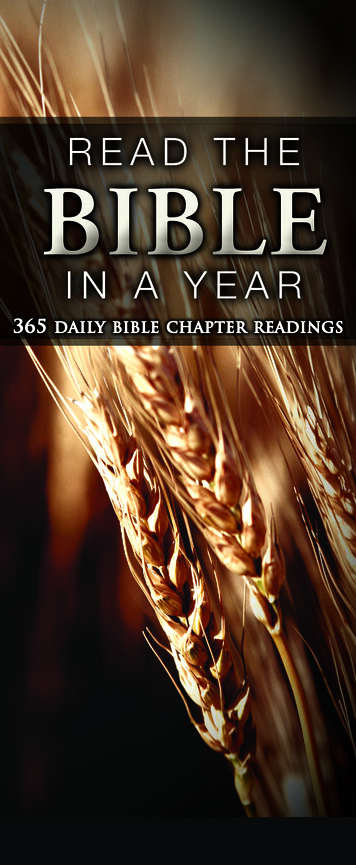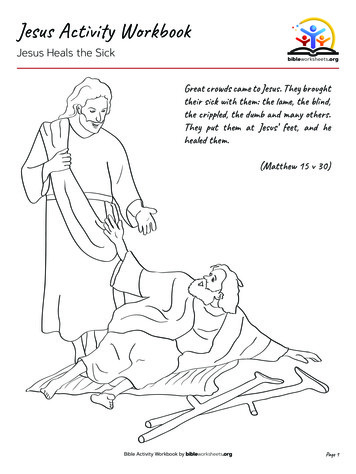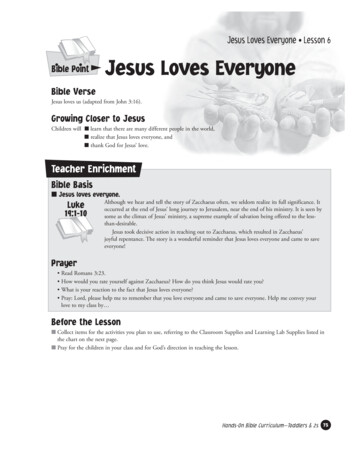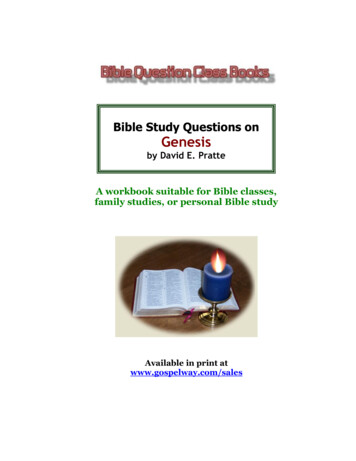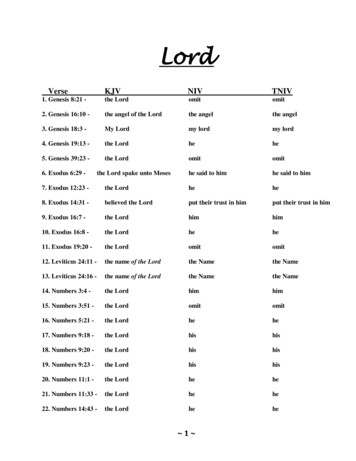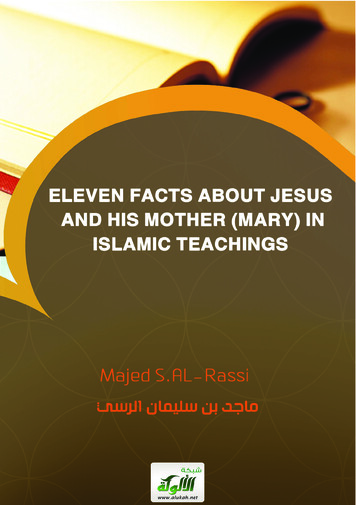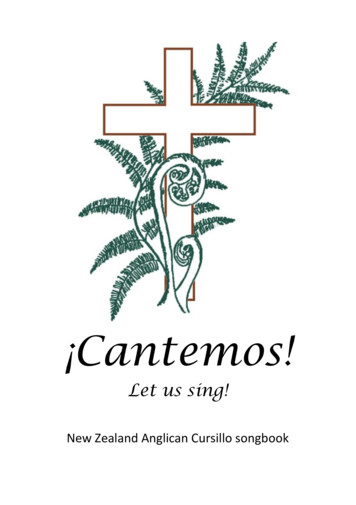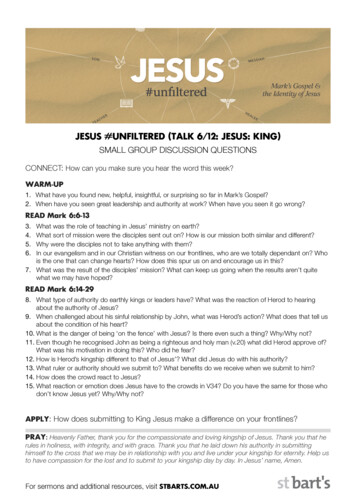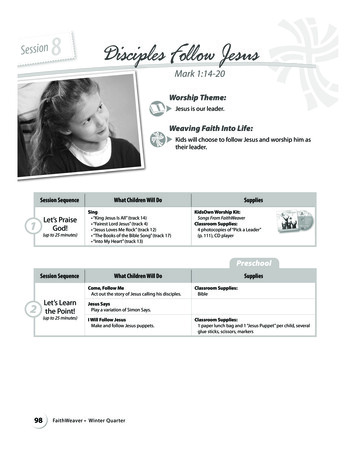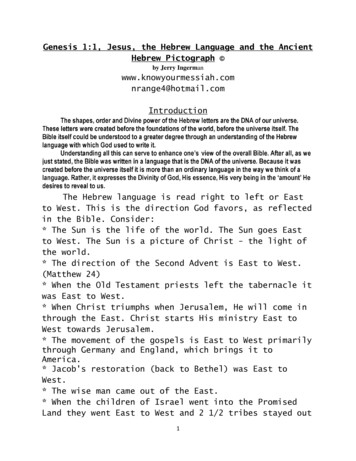
Transcription
Genesis 1:1, Jesus, the Hebrew Language and the AncientHebrew Pictograph by Jerry IntroductionThe Hebrew language is read right to left or Eastto West. This is the direction God favors, as reflectedin the Bible. Consider:* The Sun is the life of the world. The Sun goes Eastto West. The Sun is a picture of Christ - the light ofthe world.* The direction of the Second Advent is East to West.(Matthew 24)* When the Old Testament priests left the tabernacle itwas East to West.* When Christ triumphs when Jerusalem, He will come inthrough the East. Christ starts His ministry East toWest towards Jerusalem.* The movement of the gospels is East to West primarilythrough Germany and England, which brings it toAmerica.* Jacob's restoration (back to Bethel) was East toWest.* The wise man came out of the East.* When the children of Israel went into the PromisedLand they went East to West and 2 1/2 tribes stayed out1
in the East and they were the first ones to go intocaptivity.* Around the tabernacle you had the priesthood campedaround it. The high priest and his sons (Aaron andMoses and his sons) camped at the eastern gate. Theycame from east to west into the tabernacle.The world turns west to east. The world is againstChrist.2
MainGenesis means "origin." The Hebrews call it by thefirst Hebrew word "Bereshith" - in the beginning. It isthe book of all beginnings. Genesis contains the "seed"for all the dealings of God with this world, theprinciples of the relationships of God with Man, and intype anticipates all future revelations of God. All themajor doctrines of the Bible are found in the book ofGenesis. The book is the foundation upon which theentire revelation of God rests. The structure of theBible, is built upon this the book of Genesis. It isthe root out of which the tree of God's revelation hasgrown. The great doctrines of the Bible are found inthis first book. They are all found somewhere inGenesis, either in type or in direct words. The entireNew Testament in its doctrinal statements rests uponthis book. It is quoted there as the Word of God agreat many times.The two most commonly attacked books in the Bibleare Genesis and Jonah. Revelation is third. Genesis istreated as a story and ridiculed as a big dream. But ifyou see Genesis as a fairy tale then the rest of theBible is an meaningless lie. However, it must berealized that the Bible is a supernatural book not onlybecause the Spirit of God breathed it into the heartsand minds of its writer, who were scores of men fromdiverse backgrounds, writers who were separated bythousands of years, but it is also supernatural in itsDivine design. It begs the question: How could menthousands and thousands of years apart from each otherunknowingly write over hundreds of controversialsubjects with such great continuity and foresight?Everything in the Bible is inseparably bound upwith its first book, Genesis. This is because Genesisgives the origin and initial explanation of all major3
biblical doctrines. Within this book there are manyrevelations. There is the revealing of three realities:God, Man and God-man. God is revealed to Man, theheart of Man is revealed, allowing Man to see his truesinful state and condition before God and Jesus Christis revealed as Messiah, Christ, Saviour , Redeemer, theMighty God, the Everlasting Father, Truth, and Lord ofLords and King of Kings.If one examines the original Hebrew in whichGenesis was written much about this Messiah can belearned. Hebrew is the language of God. ConsiderGenesis 1:1.Genesis 1:1 In the beginning God created the heavenand the earth. אשׁית ֖ ִ בּ ְֵר בּ ָ ָ֣רא אֱ ִ ֑הים ֵ ֥את הַ שָּׁ ַ ֖מי ִם ו ֵ ְ֥את הָ ָא ֶֽרץ׃ In the beginningcreatedGodthe heavensandthe t One/Jesus and the Aleph-Bet/jesus and the alephbet.html- Consider again, Hebrew is read right to left. Sowe have aleph-tav representing the first and the lastletters of the Hebrew alphabet.Isaiah 41:4 Who hath wrought and done [it], callingthe generations from the beginning? I the LORD, thefirst, and with the last; I [am] he.Isaiah 44:6 Thus saith the LORD the King of Israel,and his redeemer the LORD of hosts; I [am] the first,and I [am] the last; and beside me [there is] no God.4
Isaiah 48:12 Hearken unto me, O Jacob and Israel, mycalled; I [am] he; I [am] the first, I also [am] Unit One/Jesus and the Aleph-Bet/jesus and the alephbet.htmlWhat is Truth?The Hebrew word emet has a more concrete meaningthan the English word for "truth" (the English wordderives from the Greek/Western view of truth as a formof correspondence between language and reality.According to the Hebraic mindset, the person who actsin emet is one who can be trusted. Actions, speech,reports, or judgment are emet because they arereliable. If a seed is a seed of emet, its quality istrustworthy.John 14:6 Jesus saith unto him, I am the way, thetruth, and the life: no man cometh unto the Father, butby me.Jesus Christ is the life, truth, heaven. Christ,not the church is the way. He didn't say he came toshow the way, but rather he is the way.5
Interestingly, Hebrew illustrates that with God in )א our lives there is truth and without God (in ourlives there is John 15:5 I am the vine, ye [are] the branches: He that abideth in me, and Iin him, the same bringeth forth much fruit: for without me ye can do nothing.Hebrew is one of the earliest alphabeticallanguages. Ancient Hebrew was originally a picturegraph based system, but later developed into the Hebrewwe are more familiar with today. Yet the pictograph6
system is still regarded important as it can give usfurther revelation and insight into the meaning ofcertain passages.The*pictographicallyrepresents (read fromright to left) Aleph ( )א signifies “an ox”, representing strength. the ox (number 1, representing strength, leadership)signifies “an ox”, representing strength. Christ is thestrong Ox who came to submit Himself as the offeringfor sin and to bear the yoke or burden of sin forhumanity. The basic Gematria for Aleph is “one”,indicating the One and only God who is the Master ofthe Universe. Jesus is the Aleph ( )א Greek 'Alpha'–Revelation 1:8 “I am Alpha and Omega, the beginningand the ending, saith the Lord, which is, and whichwas, and which is to come, the Almighty.”*Likeother ancient writing systems, the Hebrewalphabet originally was written using apictographic script. Later, the pictograms evolved intoa Hebrew script (sometimes called Paleo-Hebrew) thatstrongly resembled the ancient Phoenician alphabet.This was the Hebrew (ketav Ivri) used by the Jewishnation up to the Babylonian Exile (or, according toOrthodox Jews, until the Exodus from Egypt). Examplescan be found on coins and clayfragments (called ostraca). Today, both the Torah andnewspapers use modernized renditions of the Aramaicstyle script, though everyday correspondence is writtenusing Hebrew cursive.7
More on Paleo-HebrewPaleo-Hebrew was completely abandoned around thetime of the destruction of the Second Temple in theyear 70 C.E. Except for the inscriptions on a fewancient Jewish coins, no remnant of Paleo-Hebrewremained. The Babylonian Talmud (Sanhedrin 21b) has apertinent discussion about these two forms of Hebrewwriting. The lost script is called Ivri or PaleoHebrew. Our familiar Hebrew script is known as Ashurior Assyrian script.Around the year 800 B.C., Paleo-Hebrew lettersbecame reworked in Babylon and the surrounding regionand evolved as the native Aramaic script. Around 275years later (about 525 B.C.) the Jews in Babylon,notably Ezra the Scribe, refined the native Aramaicletters and developed Ashuri, the script recognizedtoday as Hebrew.http://www.jewishmag.com/160mag/original hebrew script/original hebrew script.htmIn the 20th century, everything changed.Archeologists began discovering buried artifactsinscribed with Paleo-Hebrew letters dating back to thetimes of King David and earlier. And then the Dead SeaScrolls were found with several examples of Paleo8
Hebrew text. The ancient Hebrew alphabet had beenresurrected from the dead.9
Genesis 1:1Note: Ancient Paleo Hebrew is the root of modernHebrew. Theis the ancient Hebrew form of the Greek10
. The Paleo Hebrew cross can be seen here asdefining a clear representation of the modern Hebrewletter(Tav). א )ב .More on the Father ( ) and the Son (11
12
13
The pictograph for א signifies“an ox”, (seegraphic above). The pictogramis a picture ofthe head of an ox, the strongest and most versatileanimals among the Hebrews livestock. The ox was used topull carts or a plow, it provided meat and leather andit was one of the animals used in sacrifices. Thisanimal was the "all" powerful and "all" versatileanimal of the Hebrews. It eventually developed into theEnglish letter 'A' (The number one letter of the א alphabet).thus represents strength and leadership.The basic Gematria for Aleph is “one”, indicatingthe One and only God who is the Master of the Universe.To repeat, the Paleo-Hebrew (pictograph) form of Alephresembles an Ox’s head. The letter means’ first’,‘strong’ or ‘leader’. It also represents the number 1in Gematria, which is a method of converting lettersinto numbers.Aleph symbolizes the One and Only, the Eternal, theOmnipotent God. It is the symbol of God as the Creatorand Master of the universe. In gematria (assigning14
numerical values to numbers) the numerical value of thealeph is 1. The parts with which the letter is formedallude to God’s sacred Name.https://www.hebrew4christians.com/Online Store/Books/WordPics/wordpics.html15
16
17
Tav, whose pictograph is the sign of the covenant,the cross (†). (See the chart of Hebrew pictographsbelow.) within the very first word of the Bible it isrevealed that God's Son will be crucified.18
cient Name: TawCrossed SticksPictograph:Mark, Sign, Signal, MonumentMeanings:TSound:History & ReconstructionThe Ancient pictureis a type of "mark," probably oftwo sticks crossed to mark a place, similar to theEgyptian hieroglyph, a picture of two crossedsticks. This letter has the meanings of "mark," "sign"and "signature."The Modern Hebrew, Arabic and Greek names for thisletter is tav (or taw), a Hebrew word meaning, "mark."Hebrew, Greek and Arabic agree that the sound for thisletter is "t."The early pictographevolved intoin the MiddleSemitic script and continued to evolve intoin theLate Semitic Script. From the middle Semitic script isderived the Modern Hebrew )ת . The Early Semitic scriptis the origin of the Greek and the Latin T.http://www.ancient-hebrew.org/alphabet letters tav.html19
The Bible confirms the existence and the meaning ofthese pictographs in Psalm 119The overall purpose of the Hebrew letters beingused in conjunction with the verses their meaningsrepresent, in effect, was to produces a memorizationtool - * To make the language stick,- * To make the people who were in exile be able tograb a section of God’s Word and memorize it with morethan just rote memorization.- * To preserve the people of Israel from beingassimilated with the pagans around them.This Psalm is an acrostic Psalm, as eight versesare allotted to each letter in the Hebrew alphabet.Each line in each section begins with the letter thatheads its section. It is the longest “chapter” in theBible so its main theme is, appropriately, the Bibleitself. The reason it is so long is that it is acomposition from the heart written to extol the virtueof studying God’s word. There are 22 letters in theHebrew alphabet. The psalmist wrote 8 verses for eachletter with all eight beginning with the same letter. 8x 22 176. The author obviously thought studying theBible was important. There are only two verses(122 132), which do not contain some term ordescription of God’s Word.“Torah” literally means instruction (and alsorefers to the five books of Moses, which are the firstfive books of the Bible—Genesis through Deuteronomy).Torah Psalms focus on the importance of God’sinstruction and the role it should play in the life ofa believer. Only three out of the 150 Psalms areconsidered “Torah” Psalms. However, the longest psalmin the Bible (119) is a Torah Psalm.Virtually every verse in Psalm 119 contains one ormore of the following keywords: law, commandments,precepts, testimonies, judgments, word, statutes, waysor name. This is significant, because it tells us thatPsalmist of Psalm 119 poured over the Torah, the law of20
God, and understood its various divisions as few othersdo. He knew that God's law represented His Name, Hischaracter and His will; that it was a transcript of theAlmighty's own soul and an everlasting fountain ofblessing. To obey God's law was the Psalmist's goal.Some commentators say that this great "Psalm of theLaw" is based upon the prophet Ezra’s presentation ofthe Law in the Book of Deuteronomy, with the spirit andlanguage of which Moses’ mind was saturated. Itrepresents the religious ideas of Deuteronomy. It isthe fruit of that diligent study of the Law which isenjoined in Deuteronomy 6:1-9. The Psalmist’s desirewas to make God's law the governing principle of hisconduct. The Law of God is not the law in the narrowersense of the Pentateuch. The Hebrew word ‘torah’ has awider range of meaning, and here it must be understoodto mean all Divine revelation as the guide of life. Itis no rigid code of commands and prohibitions, butrather a body of teaching.Ezra was a scribe for the king while in Babylonianexile and had a vested interest in preserving theJewish faith, particularly especially the language.Deuteronomy 28:49 points out that a foreign tonguewould come into the land and rule over the Jewishpeople if they, as a nation rejected Gods Laws andStatutes. But whenever the nation was carted off andput in a foreign land the language would change andmerge with the languages whenever they were out of theLand. Ezra understood that principle and sought topreserve the language from deterioration. One way hedid this is as follows:The Psalm 119 connection to Ezra is that, asmentioned, the Alphabet is included in between thevarious verse sections. A deeper look into the alphabetshows that the alphabet characters had meaning. Thatmeaning constituted a theme that would be discussed inthe verses to follow the letter. (Underlined sectionsindicate where the Psalm may relate to the Hebrewletter that heads its verse group.)21
Psalm 119 א Psalms119:1 Blessed [are] the undefiled in the way,who walk in the law of the LORD.The First Psalm opens with the Aleph word ’ (Ashri,Blessed). The basic Gematria for Aleph is “one”,indicating the One and only God who is the Master ofthe Universe.Again, א signifies“an ox”, (see graphic above).The pictogramis a picture of the head of an ox,the strongest and most versatile animals among theHebrew livestock. The ox was used to pull carts or aplow, it provided meat and leather and it was one ofthe animals used in sacrifices. This animal was the"all" powerful and "all" versatile animal of theHebrews. This letter has an "a" sound, but also an "e"sound as in elk and elephant, both of which are alsopowerful animals. The name of this letter is "aleph,"which may be the origin of "elephant." representingstrength. Christ is the strong Ox who came to submitHimself as the offering for sin and to bear the yoke orburden of sin for humanity. The first letter is the(aleph - A), a picture of an ox. As the ox is strong,the letter also has the meaning of strong. The secondletter, (bet - B), is the picture of the tent or housewhere the family resides. When combined these lettersform the noun AB (pictograph) meaning "the strengthof the house" and represents the "father."Jesus is the Aleph (Greek: Alpha) –Revelation 1:8 “I am Alpha and Omega, the beginningand the ending, saith the Lord, which is, and whichwas, and which is to come, the Almighty.”Loyal obedience to God's Law is the source of Man'struest happiness. The Psalmist prays that it may be amain concern of his life and that he may learn tounderstand it better.22
Psalms 119:2 Blessed [are] they that keep histestimonies, [and that] seek him with the whole heart.Psalms 119:3 They also do no iniquity: they walk inhis ways.Psalms 119:4 Thou hast commanded [us] to keep thyprecepts diligently.This verse calls attention to the Author of the Lawand to the purpose of its enactment (Deuteronomy 4:2).Psalms 119:5 O that my ways were directed to keep thystatutes!A prayer for God’s direction in the right way.Psalms 119:6 Then shall I not be ashamed, when I haverespect unto all thy commandments.Psalms 119:7 I will praise thee with uprightness ofheart, when I shall have learned thy righteousjudgments.The Psalmist knows that he has not yet attained acomplete knowledge of God's revealed Will, but he givesthanks for the progress that he does make.Psalms 119:8 I will keep thy statutes: O forsake menot utterly. ב Psalms 119:9 Wherewithal shall a young man cleanse his way? by taking heed[thereto] according to thy word. ( א Aleph, Ox(Strong Leader/Guide) and ( ב Beyt, House) TheFather is the Head of the House - Aleph. Aleph ( ) א is the Father's Initial, Beyt( ) ב is the Son's Initial, and the Divine Alphabet beginsas an acronym of Father ( )א and Son ( )ב , the first two(Av, Father) Divine Persons.A love for God's Law is the safeguard and the joyof life.“Beyt” means a house or a tent. The Pictogram. TheHebrews lived in goat hair tents, which were dividedinto two halves, male and female sections, and divided23
by a wall. The picture of this letter is arepresentation of the floor plan to the tent. The tentwas the place where the family laid their "bed". Thename of this letter is Beyt and has a "b" sound. Thisletter is a picture of a nomadic tent such as wouldhave been used by the ancient Hebrews and representswhat is inside the tent - the family. The meaning ofthis letter can be tent or within. When this letter isplaced in front of the word erets the word be'erets isformed and means "within a land." Jesus tabernacledwith us after “clothing” Himself in a 'tent' of humanflesh.‘young man’ – See Proverbs 1-6.The young man needs help to keep himself pure from sin(Psalm 27:7).Psalms 119:10 With my whole heart have I sought thee:O let me not wander from thy commandments.Psalms 119:11 Thy word have I hid in mine heart, thatI might not sin against thee.The main purpose of Bible memorization is to getsin out of our lives.Psalms 119:12 Blessed [art] thou, O LORD: teach methy statutes.Psalms 119:13 With my lips have I declared all thejudgments of thy mouth.Psalms 119:14 I have rejoiced in the way of thytestimonies, as [much as] in all riches.Psalms 119:15 I will meditate in thy precepts, andhave respect unto thy ways.Psalms 119:16 I will delight myself in thy statutes:I will not forget thy word. ג Psalms 119:17 Deal bountifully with thy servant, [that] I may live, and keep thyword.Gimmel means “foot”, pictograph ( ).The picture isthe foot of a man. The Hebrews were always on theirfeet for traveling. The letterhas the meanings ofwalk, carry or gather. The sound associated with thisletter is a "g" as in "go".24
Aleph (1) and Bet (2) equal Gimmel (3) (their numericalvalues), suggesting that Gimmel (3) represents the HolySpirit proceeding forth from the Father (Aleph) and theSon (Beth). In the Talmud it is said that Gimmelsymbolizes a rich man running after a poor man (thenext letter “Dalet”) to give him charity. Dalet inHebrew means “impoverished”. Gimmel thus represents thefree choice to run after the teaching of Torah bypracticing acts of lovingkindness. The purpose forstaying alive is to keep God’s Word.Psalms 119:18 Open thou mine eyes, that I may beholdwondrous things out of thy law.Natural sight is unable to discern the mysteries ofDivine revelation; so he prays for the removal of theveil from his eyes.Psalms 119:19 I [am] a stranger in the earth: hide notthy commandments from me.A stranger or sojourner is a traveler residing in acountry not his own, needs to be instructed in the lawof that land so that he may not break it.Psalms 119:20 My soul breaketh for the longing [thatit hath] unto thy judgments at all times.Psalms 119:21 Thou hast rebuked the proud [that are]cursed, which do err from thy commandments.Psalms 119:22 Remove from me reproach and contempt;for I have kept thy testimonies.This sounds Messianic. As it is connected with (21)the request here is for removal of the rebuke of theproud.Psalms 119:23 Princes also did sit [and] speak againstme: [but] thy servant did meditate in thy statutes.‘Princes’ was the title commonly given to the Israelitenobles in post-exilic times and the Psalmist wasevidently persecuted by wealthy and powerfulcountrymen.Psalms 119:24 Thy testimonies also [are] my delight[and] my counsellors.While he is scorned by men he can still find delight inGod's law.25
ד Psalms119:25 My soul cleaveth unto the dust: quickenthou me according to thy word.This can be Messianic. It can be connected with(21).Dalet - Pictogram. The entrance of theHebrew's tent was covered by a curtain suspended from ahorizontal pole. The picture of this letter representsthe "door" of the tent. The bent shape of the Daletsymbolizes a needy person who is bent over (the wordDalet comes from (dalah) meaning to draw out orimpoverish and the word (dalut) means poor orimpoverished). Dalet's ear is said to be listening forthe approaching Gimmel. Dalet also means “a door”.John 10:7 Then said Jesus unto them again, Verily,verily, I say unto you, I am the door of the sheep.John 10:9 I am the door: by me if any man enter in, heshall be saved, and shall go in and out, and findpasture.God will rebuke those who despise His Word anddeliver His servants from their reproach.Psalms 119:26 I have declared my ways, and thouheardest me: teach me thy statutes.As a ‘needy’ stranger (19) he needs guidance anddirection.Psalms 119:27 Make me to understand the way of thyprecepts: so shall I talk of thy wondrous works.Psalms 119:28 My soul melteth for heaviness:strengthen thou me according unto thy word.When his soul dissolves in tears (Job 16:20) heasks for strength, according to God’s Word. The Word ofGod strengthens a sinner (Acts 20:32).Psalms 119:29 Remove from me the way of lying: andgrant me thy law graciously.All behavior that is not governed by God's Truth iscontrasted with the way of faithfulness. The way oflying can become one’s lifestyle.26
Psalms 119:30 I have chosen the way of truth: thyjudgments have I laid [before me].The way of truth in the Old Testament – OldTestament salvation (Micah 6:8).Psalms 119:31 I have stuck unto thy testimonies: OLORD, put me not to shame.Old Testament praying, not New Testament praying.Psalms 119:32 I will run the way of thy commandments,when thou shalt enlarge my heart. ה Psalms 119:33 Teach me, O LORD, the way of thy statutes; and I shall keep it[unto] the end.The meaning of the name “Hey”( )ה is “look,” or “behold!” It also means a“lattice” or a “window” (Song of Solomon 2:9). PictographThe picture is of a man with his arms outstretched,pointing toward a wonderful view and saying "hey" lookat that.Psalms 119:34 Give me understanding, and I shall keep thy law; yea, I shallobserve it with [my] whole heart.Psalms 119:35 Make me to go in the path of thy commandments; for therein do Idelight.Psalms 119:36 Incline my heart unto thy testimonies, and not to covetousness.A prayer to be delivered from covetousness, as (29) was a prayer to bedelivered from lying. (Isaiah 36:15). This leads him to (37).Psalms 119:37 Turn away mine eyes from beholding vanity; [and] quicken thoume in thy way.- so he can fulfill the covenant that Job made with his eyes (Job 31:1). The“five steps to sin” start with looking with the eyes.The 5 steps to sin:1) the presentation - you see it – you look2) the illumination - it lights up in your brain3) debate - you debate about whether or not you’re going to do something4) decision - you make a decision to do something5) the act of doing it yourselfPsalms 119:38 Stablish thy word unto thy servant, who [is devoted] to thy fear.Psalms 119:39 Turn away my reproach which I fear: for thy judgments [are]good.27
Psalms 119:40 Behold, I have longed after thy precepts: quicken me in thyrighteousness. ו Psalms 119:41 Let thy mercies come also unto me, O LORD, [even] thysalvation, according to thy word. ו Vav ( ) denotes a nail, a hook, nail or a tent peg.Meaning: Add, Secure, Hook. As the pictographindicates, this letter represents a peg or hook, whichis used for securing something. The meaning of thisletter is to add or secure. Since it occurs as the 22ndletter in the Torah attached to the sixth word, , italludes to the creative connection between all of theletters. Vav is therefore the connecting force of theGod, the Divine "hook" that binds together heaven andEarth.Exodus 36:36 And he made thereunto four pillars [of]shittim [wood], and overlaid them with gold: theirhooks [were of] gold; and he cast for them four socketsof silver. ָווֵי ֶה – “their hooks” – In Hebrew the word “hooks” isliterally written using ‘Vav’s.Psalms 119:42 So shall I have wherewith to answer himthat reproacheth me: for I trust in thy word.Psalms 119:43 And take not the word of truth utterlyout of my mouth; for I have hoped in thy judgments.This would allow him to keep preaching. Preachingdrives the nail. This nailing of one’s conscience isconviction. The Bible then clinches the issue. A wisesaying: “For want of a nail, the shoe was lost; forwant of a shoe, the horse was lost ”Psalms 119:44 So shall I keep thy law continually forever and ever.Psalms 119:45 And I will walk at liberty: for I seekthy precepts.Psalms 119:46 I will speak of thy testimonies alsobefore kings, and will not be ashamed.Psalms 119:47 And I will delight myself in thycommandments, which I have loved.28
Psalms 119:48 My hands also will I lift up unto thycommandments, which I have loved;and I will meditate in thy statutes. ז Psalms119:49 Remember the word unto thy servant,upon which thou hast caused me to hope. ז Zayin ( ) looks like a sword . It means “a weapon”. The sword of war is oftenneeded for our nourishment in the spiritual sense, that in order to be nourished andat rest we must sometimes engage in warfare. Meaning: Food, Cut, Nourish.Psalms 119:50 This [is] my comfort in my affliction:for thy word hath quickened me.The life-giving sustaining power of God's Promise isHis comfort in affliction.Psalms 119:51 The proud have had me greatly inderision: [yet] have I not declinedfrom thy law.He is under affliction and the derision of theproud, yet he can defend and comfort himself with thesword, which is the Word of God.Psalms 119:52 I remembered thy judgments of old, OLORD; and have comforted myself.A Messianic verse. (52-56) could all be claimed byJesus Christ.Psalms 119:53 Horror hath taken hold upon me because ofthe wicked that forsake thylaw.Psalms 119:54 Thy statutes have been my songs in thehouse of my pilgrimage.Psalms 119:55 I have remembered thy name, O LORD, inthe night, and have kept thylaw.Psalms 119:56 This I had, because I kept thy precepts. ח Psalms 119:57 [Thou art] my portion, O LORD: I havesaid that I would keep thy words.Cheth ( )ח means a “hedge” or a “fence”. The ancientpictographis a picture of a tent wall. According tothe Jewish mystics, Cheth is the letter of life, since29
(chayim - life) and (chayah - living) both begin withthis letter. Cheth ((8)) is also the number of grace,(chen) and the number of wisdom (chokhmah).Graciousness can be equated with mercy Psalms 116:5 “Gracious [is] the LORD, and righteous;yea, our God [is] merciful.”Psalms 119:58 I intreated thy favour with [my] wholeheart: be merciful unto me according to thy word.Psalms 119:59 I thought on my ways, and turned my feetunto thy testimonies.Psalms 119:60 I made haste, and delayed not to keepthy commandments.Psalms 119:61 The bands of the wicked have robbed me:[but] I have not forgotten thy law.- strongly Messianic This verse contains a metaphorfor the snare or noose of the hunter.Psalms 119:62 At midnight I will rise to give thanksunto thee because of thy righteous judgments.Psalms 119:63 I [am] a companion of all [them] thatfear thee, and of them that keep thy precepts.- a general confession of faithPsalms 119:64 The earth, O LORD, is full of thy mercy:teach me thy statutes.Doctrinally, this will be the Millennial Earth.Spiritually, God has often showed mercy to Man over theyears. ט Psalms 119:65 Thou hast dealt well with thy servant,O LORD, according unto thyword.Teth ( ) ט lookslike a snake coiled inside a basket.It is generally interpreted as a serpent.Thepicture is a basket or "tote" used for storing foods orbelongings. The serpent in the Bible was proud.Psalms 119:66 Teach me good judgment and knowledge:for I have believed thy commandments.30
There are 66 books in the Bible. Believing mustprecede teaching.Psalms 119:67 Before I was afflicted I went astray:but now have I kept thy word.Psalms 119:68 Thou [art] good, and doest good; teachme thy statutes.God is good and he does good (Deuteronomy 8:16).Psalms 119:69 The proud have forged a lie against me:[but] I will keep thy precepts with [my] whole heart.Satan is proud. He is a serpent in the Bible.Psalms 119:70 Their heart is as fat as grease; [but] Idelight in thy law.The proud have more ‘fat’ of the world than theirhearts could wish for.Psalms 119:71 [It is] good for me that I have beenafflicted; that I might learn thy statutes.Psalms 119:72 The law of thy mouth [is] better unto methan thousands of gold and silver. י Psalms119:73 Thy hands have made me and fashionedme: give me understanding, that I may learn thycommandments. י Yod ( ) means “hand” or “right hand”. the pictograph is. Yod isthe
Paleo-Hebrew was completely abandoned around the time of the destruction of the Second Temple in the year 70 C.E. Except for the inscriptions on a few ancient Jewish coins, no remnant of Paleo-Hebrew remained. The Babylonian Talmud (Sanhedrin 21b) has a pertinent discussion about these two forms of Hebrew writing. The lost script is called Ivri .


